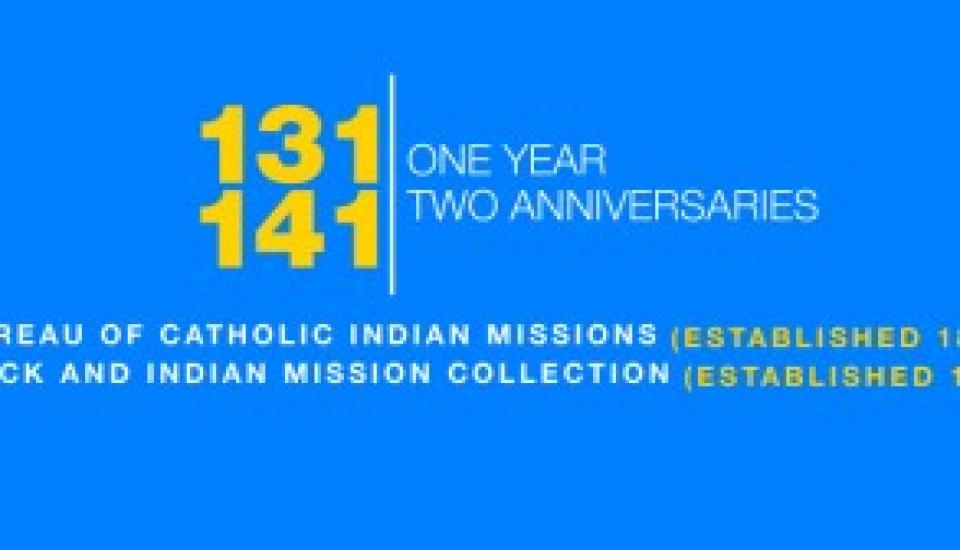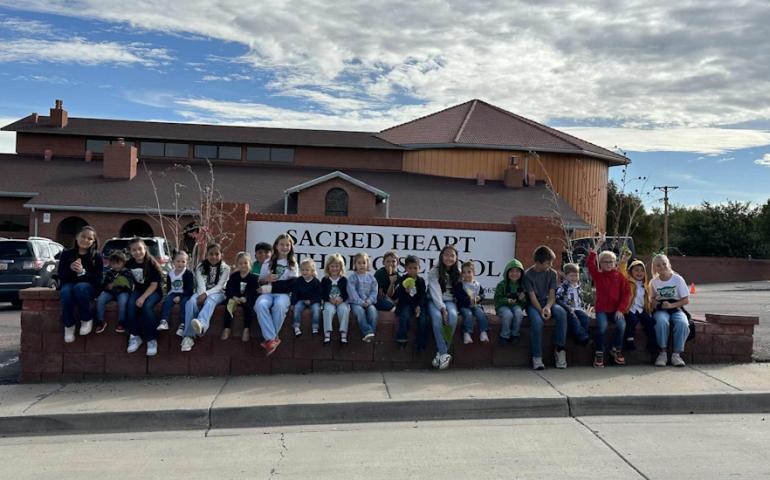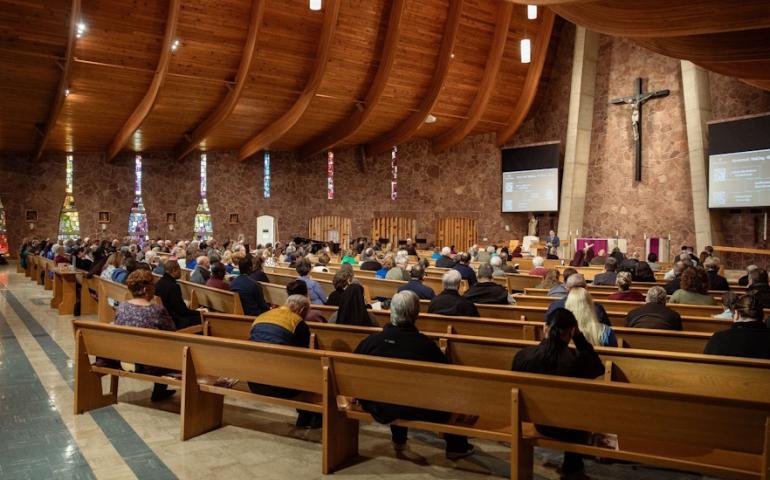
Monsignor Stephan and the Indian Schools
Second in a series of historical reflections by Tim Lanigan
The late 19th Century was a time of testing for the newly established Bureau of Catholic Indian Missions. The two principal founders of the Bureau died within a year of each other. Brigadier General Charles Ewing, the Bureau’s founding commissioner, died in mid-1883; Father John Brouillet, the first director, in early 1884. Both men, as recounted in the Spring 2014 issue of the Sentinel, had worked hard, over a period of ten years, to put the Bureau on a solid footing.
The two men sought and received a more formal recognition of the Bureau from the Vatican; they raised funds to support the Bureau’s offices and its missions; and they helped create many more schools in the missions. It was this last effort that created the biggest challenge in the following 17 years. At the time the Bureau was founded, there were only three Catholic boarding schools for Indians. Ten years later, there were eighteen. By 1890, there were 43 boarding and 17 day schools, with the federal government paying almost $400,000 to support the schools.
This remarkable success was a mixed blessing. It gave many more Indian youngsters the opportunity to learn what they needed to know to prosper in a changing world and introduced them to the fundamentals of Catholic Christianity. But at the same time, this very successful program aroused the envy of other Christian denominations and led to a fight that pitted the Bureau’s new director against the new director of the federal government office that administered Indian Affairs.
On one side was Msgr. Joseph A. Stephan, who served as director of the Bureau of Catholic Indian Missions from 1884 to 1901. On the other was Thomas Morgan, the federal government’s Commissioner of Indian Affairs, brigadier general in the Civil War, an educator, and a Baptist minister.
The Fighting Priest
Msgr. Stephan came to this assignment through an unusual route. Born in 1822 in the Grand Duchy of Baden, in the south-western region of present-day Germany, he had worked as a carpenter and later as a military officer, before studying civil engineering and later philology at two schools in Germany.
While studying philology, he was struck blind for unknown reasons. According to Kevin Abing of Marquette University, “Stephan turned to God in this trial. He reportedly pledged to become a priest if his eyesight returned,” which it did two years later. He made good on his vow, but in 1847, while studying scholastic philosophy in preparation for the priesthood, Stephan learned that his father, who had emigrated to the United States, was dying. Leaving for the U.S. in 1847, Stephan arrived in time to visit his father one last time before he died.
Stephan remained in the States, deciding to pursue his theological studies in a seminary of the Diocese of Cincinnati. He was ordained in 1850 and served parishes first in Ohio and later in Indiana. Both states were on America’s frontier at the time, which called for people who could apply a wide range of skills in building up the new regions. Msgr. Stephan was well prepared. As told by Abing, he was well-educated, a trained engineer, a musician, and a cook. He was an inspirational speaker, a bundle of energy, and a strong administrator, which were necessary skills in building, and in some cases, rebuilding, parishes.
Commissioned a chaplain during the Civil War, he not only ministered to the troops but also helped design and build a pontoon bridge, an achievement that so impressed his superior officers that they urged him to make a career in the military.
He turned the offer down and eventually became committed to the cause to which he would devote the rest of his life, the well-being of the American Indian. In 1878, while serving within the Diocese of Fort Wayne, Indiana, he applied for a position as the government’s agent in the Standing Rock reservation in the Dakotas.
Msgr. Stephan found the job of agent a tough assignment. He complained of dealing with the missionaries who worked at the schools and the soldiers who manned the garrison at Fort Yates. He found the Indians to his liking, “a peaceable, industrious, and good” group, as he called them. The whites he accused of “harassing, backbiting, and lying,” adding he was disgusted with the place. So it was no surprise that Stephan, an impatient man with the temperament of a fighter, resigned from the assignment in 1881, three short years after accepting it.
But that certainly did not end his relationship with Indian affairs. In 1884, after serving for three years in parishes in the Dakotas, Msgr. Stephan was chosen to head the Bureau of Catholic Indian Missions, replacing Father Brouillet.
In the 1870s and 1880s, Congress simply wasn’t willing to appropriate large sums of money for the government-run schools for Indians. Even by 1887, for example, these schools were educating only 10,000 students out of an Indian population of 300,000. And the teaching and administrative positions at the schools were often handed out on the basis of political patronage, a situation too open to incompetence and corruption.
In the mid-1870s, the government found a way to circumvent these problems. It funded the schools, but left the staffing and administration of them to religious and charitable groups, institutions more likely to spend the money wisely and honestly. These schools not only offered academic training, but religious instruction and example as well.
But it was the success of the Catholic-run schools that led to the program’s demise. By 1890, almost two-thirds of the government funding went to Catholic-run schools, a situation that dismayed the largely Protestant national leadership of the time.
The success of the Catholic schools played into the hands of American nativists, who had once recoiled at the sight of boatloads of Irish Catholics arriving in New York harbor and Boston harbor in the 1840s and 1850s. If the nativists were upset during this period, they were shocked by what followed after the Civil War.
The Issue Behind the Conflict
Between 1880 and 1921, almost 24 million immigrants arrived in America. This was an enormous increase to the 1880 population of 50 million. But it wasn’t the size of the population shift alone that stirred emotional debates. Where many immigrants in the early 19th Century had come from such northern and western European countries as Ireland and Germany, this second wave of immigration was largely from such southern and eastern European countries as Italy, Poland, and Russia. Catholics made up a large percentage of this new wave of immigration. In 1850 Catholics made up only five percent of the total U.S. population. By the first decade of the 1900s, their numbers had arisen to 14 million, or 17 percent of the total population. By then, Catholics were the largest single religious denomination in the country. Those politicians and educators and writers who had long seen America as white, Anglo-Saxon, and Protestant were stunned by the abrupt change in the culture, and they fought back.
The arrival of immigrants from the non-English speaking, largely Catholic parts of Europe gave rise to such groups as the American Protective Association, an anti-Catholic society created by Protestant groups in 1887. Among the Association’s policy objectives was the complete separation of Church and State. That goal included the promotion of a non-sectarian public school system and a prohibition of any government funding of religious groups, an outcome, if enacted in public law, would have a profound effect on the education of American Indians.
The case of many of those who opposed the Catholic schools was simple: Indians should be educated in public schools. Their argument might have been summed up like this: The more people are like each other, the more peaceful society will be. America has had an identity, one that is white, Anglo-Saxon, and Protestant. That identity should be passed on to future generations, whether descendants of early settlers, new immigrants, or American Indians. Education, many thought, was the best way to hand down a common culture. In fact, early advocates of public education often referred to public schools as “common schools.” Of course, back then it was assumed that a real education would be permeated with Christianity. The question was: whose version?
To virtually all of the people who made public policy in those days, the answer was simple: the Christianity that the Pilgrims and Puritans and Anglicans brought from England in the early 17th Century. This identity was passed on to generations in the 19th Century through McGuffey Readers, the most widely used textbooks ever created in America. These readers brought students the basic skills of reading through stories, poems, and essays that offered moral and spiritual uplift, and that not so incidentally created an impression of a white, Anglo-Saxon, Protestant as the model American. The world views of virtually all of the late 19th Century public figures Msgr. Stephan worked with were no doubt informed by these texts and others like them.
Among the Protestant leaders was Thomas Jefferson Morgan. Morgan was certainly Msgr. Stephan’s most combative and determined foe. Msgr. Stephan represented Catholic Indian schools during five presidential administrations, but it was during the presidency of Benjamin Harrison, from 1889 to 1893, that the debate was most heated. It was also during this administration that the general outlines of a final resolution to the issue of government funding were resolved.
Harrison had been Morgan’s old commander in the Civil War. After the war he went on to become a lawyer, a Presbyterian elder, and a U.S. Senator. In 1888, Harrison, a Republican, was elected president. He shared a similar philosophy with Morgan and when it came time to appoint a new commissioner of Indian Affairs, Harrison chose his former Civil War subordinate.
The choice of Morgan was bound to be divisive. He was profoundly anti-Catholic, a zealous member of an anti-Catholic organization, the League for the Protection of American Institutions, and was in his later years an outspoken member of the nativist American Protective Association.
But Morgan’s animus toward the contract schools was not simply a matter of anti-Catholicism. His advocacy of public education also shaped his views about schools run by the Catholic Church. His background as a Baptist minister and an educator convinced him that the best way to pass on the “civic culture” was through public education. The civic culture he had in mind was a largely Protestant culture, as typified by the historical textbooks of the time, which stressed the stories of the Puritan and Anglican founders of the nation. The easy equation of public education and the Protestant religion “was part of the spirit of the age,” as Father Francis Paul Prucha, S.J., put it in his comprehensive history of the issue, The Churches and the Indian Schools, 1888-1912.
Msgr. Stephan felt he had no choice but to lead the challenge to the nominations of Morgan and especially the man Morgan chose as Superintendent of Indian Schools, the Reverend Daniel Dorchester. Dorchester was a Methodist clergyman and a virulent anti-Catholic, who just prior to his nomination wrote that the Catholic Church was plotting to destroy American institutions.
Msgr. Stephan fought tirelessly against the nominations of Morgan and Dorchester, but to no avail. Both were confirmed by the Senate after a long, drawn out struggle led by Stephan, who was supported by such Church luminaries as James Cardinal Gibbons, Archbishop of Baltimore and the senior American prelate, as well as two other archbishops, John Ireland of St. Paul, Minnesota, and Patrick W. Riordan of San Francisco. Stephan had cultivated many friends and allies in Congress as well. But the momentum behind the unstoppable trend toward public education and the negative public reaction to the arrival of so many recent immigrants helped push the two nominations through the Senate.
It was clear from Morgan’s advocacy of public education and from his general dislike of the Catholic Church that he was determined to defund the Catholic Indian contract schools. His arguments still resonate in battles over the proper relationship between Church and State today.
Morgan and his allies charged that the government-supported schools violated the principle of the separation of Church and State. They argued that the Catholic religion was alien to America’s long-standing principles and ideals, especially the principle of popular democracy. This charge they supported by accusing the American Church of reporting to a foreign power, namely, the Pope. One Morgan ally, the Reverend James M. King, described America’s identity this way: “Our civilization is not Latin, because God did not permit North America to be settled and controlled by that civilization.”
Msgr. Stephan and his allies responded by pointing out that Catholics staffed the Indian contract schools because of a government invitation to do just that, largely because of its inability to staff all of them itself. He pointed out all the good work that the Church had done in the schools and that the government didn’t have the resources to replace the schools, arguments that opponents of the contract schools readily conceded. Archbishop John Baptist Salpointe of Santa Fe, New Mexico, pointed out that the schools in many cases had been developed after long years of hard work and that to destroy these institutions was unfair. He added, pointedly, that if given the choice between government and Catholic schools, the Indians in his archdiocese would most certainly choose the Catholic schools.
At the urging of some of his allies, Morgan softened his position somewhat, but not enough to make a difference in the long-run funding of the schools. In the face of numerous attacks on his proposal, and even his character, Morgan pointed out that he had actually increased funds to contract schools, that he wouldn’t close them suddenly, but that he had no intention of backing down on his overall plan of replacing such schools with government-run institutions. The issue came to a head in 1891 when the Protestant churches agreed to reject government funding for their Indian schools as a way of pressuring the Catholics to do the same. Of course, they were confident that government-run schools would emphasize the same Protestant values that such schools had since the beginning of the public school system.
The contract schools question became a heated issue during the 1892 presidential campaign. Harrison lost to the man he had replaced in 1889, Grover Cleveland, a Democrat, and someone who was more likely than the Republican Harrison to curry favor with Catholic voters. Both Morgan and Dorchester were replaced by Cleveland, but the Democratic victory couldn’t reverse the trend to public education. That became more clear when Cleveland appointed Daniel Browning as Commissioner of Indian Affairs rather than reappoint the commissioner who served in Cleveland’s first administration and who was the favorite of the Catholic hierarchy.
Msgr. Stephan continued the fight over the 1890s, relying primarily on his allies in Congress. But Congress gradually defunded the contract school program over the succeeding years, until it finally stopped all aid in 1900. That year, William A. Jones, Commissioner of Indian Affairs in the William McKinley administration, wrote to Stephan, inquiring which schools he intended to close so that Jones could transfer their students to the government schools. Stephan’s reply: none of them. He was determined that none of his more than 2,000 students should be deprived of a Catholic education, even though it would cost the Bureau about $150,000 a year. It was a bold decision, very characteristic of the immigrant priest who devoted his life to serving the well-being of Native Americans.
But Msgr. Stephan’s years in Washington had sapped his energies. In 1900, he had traveled to Europe to regain his health. After returning to the United States, he was attending a convention in Washington, and died very suddenly in September of 1901.
When he passed away, he was no doubt confident that his work with the American Indian schools had not been in vain. And with good reason. Over the years, he had developed a friendship with one of America’s great saints, a woman who helped see to it that the Bureau of Catholic Indian Missions would continue its work with America’s original inhabitants. But that story can await the arrival of the man who would replace Msgr. Stephan: Monsignor William H. Ketcham.






